 |
| It is He Who is Allah in heaven and Allah on earth; and He is full of Wisdom and Knowledge.(Qur'an, 43:84) |
Three scientists who won the 1998 Nobel Prize in Physiology or Medicine discovered that molecules of nitric oxide (NO), released by blood vessels, had the ability to relax them. The NO molecule regulates tension in the walls of blood vessels, but doesn't carry out this act by itself. Rather, it functions as a mediator in relaxing the blood vessel.
To understand how this cascade process works, examine the diagram on the next page. For the vessels to relax, first of all some hormones in the blood start the process by sending an alert, binding to receptors found in the blood vessel lining. We can compare this to a domino effect, when a single domino falls and brings down a whole row of others. Immediately after the hormone sets off an alert signal by binding to the receptor, the vessel lining "realizes" what it must do and begins producing nitric oxide. Some of the NO molecules, "knowing" what they have to do as soon as they are released, head quickly for the vascular smooth muscle cells. Entering the cells, they bind to an enzyme.
This is the second step. But in order for the vessel to relax, yet a third step must be reached. Once NO has combined with the enzyme in the smooth muscle cell, GTP (guanosine triphosphate) is converted to cyclic guanosine monophosphate, or cGMP. Obviously, this newly synthesized molecule has a role to play in this cascade and, to bring this about, it makes its way to myosin. Myosin is a necessary protein needed in the contraction and relaxation of muscle cells. Here, the final step has been reached. With the action of myosin the last domino falls, and the muscle cells relax.
Reviewing these steps again, we see that the hormones and cells taking part in this process act in a thoroughly knowledgeable manner. The alerting hormones found in the blood go to the appropriate place, influencing the vessel lining and initiating the process. Similar insight is displayed throughout the rest of the whole process. Every signal makes its way to the correct place in the body, never getting lost in that very dark place, and always meeting with success.
But how can these cells, hormones and molecules effect such conscious actions? Could this consciousness be one of their innate properties? Certainly not! But knowledge and consciousness is certainly necessary to direct all these processes, to let cells know when and what to produce and to inform hormones and other molecules of the correct "address" and show them the way. The inspiration of this infinite knowledge, informing the cells, hormones and other molecules of their necessary actions, emanates from God.
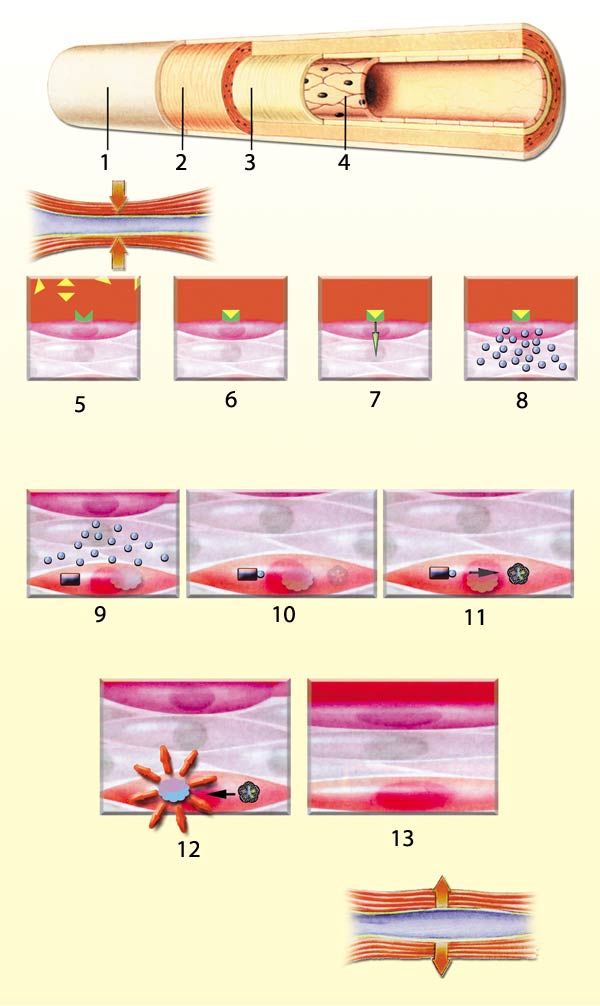 |
| 1. Outer layer |
It's highly illogical to claim that millions of events, all occurring by coincidence, gave life to inanimate matter and formed perfectly working processes and structures of faultless design. To realize this, you need only to consider the following example:
One of the transport proteins in the blood, called albumin, binds to lipids such as cholesterol and to hormones, toxic bile and medicines such as penicillin. Then it circulates through the bloodstream traveling throughout the body after which it arrives at the liver and deposits the toxins it has gathered there to be neutralized, and then continues on carrying the nutrients and hormones to wherever they need to go.
Now ask yourself these questions:
1. How can a molecule like albumin, made up of atoms and having no consciousness or knowledge, distinguish between lipids and toxins, medicines and nutrients?
2. Moreover, how can it recognize the liver, bile, and stomach and then deliver the correct substances to the correct places every time, never getting confused or losing its way?
If you examined the toxins, medicines and nutrients carried in the blood under a microscope you wouldn't be able to distinguish between them unless you had medical training. Certainly you couldn't determine how much and of which type of substance needed to go to which organ.
A few unconscious atoms, combined into the albumin protein, have been faultlessly carrying out this duty in the bodies of all human beings for millions of years—a process that the majority of human beings couldn't manage if they hadn't any training. Undoubtedly this display of purpose and intent by a group of atoms is possible only by the infinite power and knowledge of God.
 |
| 1. Capillaries |
| Your deity is God alone, there is no deity but Him. He encompasses all things in His knowledge. (Qur'an, 20: 98) |
The most effective way to show that coincidences have no powers to create is to expound on the proofs of God's existence. Take an example from your own body.
Whether standing up or raising your arms, all your movements are carried out as a result of the action of your muscles. For us to perform these actions, our muscle cells require a continuous supply of oxygen. The duty of transporting oxygen to the muscle cells has been taken up by one of our body's proteins called myoglobin. It very much resembles hemoglobin, another protein whose duty is to transport oxygen in the blood. But the difference between the two is that myoglobin has the capacity to carry only one single oxygen molecule. Due to this feature of myoglobin, flow of oxygen to muscle cells is carried out in a slow, regulated manner.
Consider that hemoglobin, the protein that transports oxygen in the blood, swaps places with the myoglobin that transports oxygen from the lungs to the muscle cells. In such a situation, myoglobin won't be able to carry sufficient oxygen to the body. On the other hand, hemoglobin will carry too much oxygen to muscle tissue and will deposit it suddenly, upsetting the balance of the entire body. But no such thing ever happens; and both proteins are always found in the right place at the right time. As a result, we breathe comfortably and we can move as freely as we please.
Of course, hemoglobin and myoglobin are only two of the proteins found in the human body. Similarly, other proteins in the body have characteristics that fulfill the body's needs and are produced where they are needed. As these examples show, it's not possible for the human body's perfect design to have come about by chance. The Possessor of this perfect design is God, the Lord of the worlds.
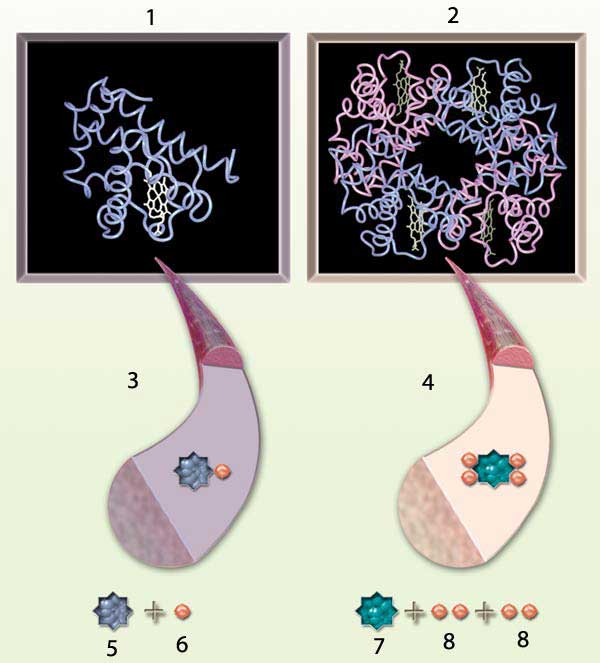 | |
| 1. Myoglobin. | 5. myoglobin |
| Myoglobin, assigned the duty of transporting oxygen to the muscles, has the capacity to carry one oxygen molecule. But hemoglobin, which transports oxygen to other tissues, has a higher oxygen-carrying capacity. In this way, each kind of tissue receives just the needed amount of oxygen. | |
| Is He Who creates like him who does not create? So will you not pay heed? (Qur'an, 16: 17) | |
 |
| To Him belongs every being that is in the heavens and on earth: all are devoutly obedient to Him. (Qur'an, 30:26) |
Due to external factors, mistakes occasionally arise in the DNA, the body's information bank. But these mistakes are fixed immediately by a control mechanism or repair process, effected by enzymes that are synthesized according to information found in the DNA itself.
The repair process is made up of a number of steps:
1. An enzyme called DNA nuclease identifies the damaged portion of the DNA strand.
2. DNA nuclease removes the identified faulty portion, creating a gap in the strand.
3. Another enzyme called DNA polymerase identifies the correct information from the undamaged strand of DNA, then repairs the damaged strand according to this undamaged model.
4. The repair process does not end here, however. A gap has been left in the sugar phosphate "backbone" in the area where the repair has taken place, but an enzyme called DNA ligase fills in this gap.
As you can understand from the functions they carry out, the enzymes that repair the DNA possess many multiple functions. In order to repair DNA, they must be very familiar with it. Moreover they must know where to get the correct information, and how to fill the gap that results.
The most amazing part is that the synthesis of DNA and the enzymes controlling its synthesis are all produced according to information stored within that same DNA, and are under the control of proteins made by that DNA. It is impossible for this magnificent system, with processes occurring within processes, to have come about in stages, by coincidence. In order for the enzymes to exist, DNA must exist to begin with; and in order for DNA to exist, the enzymes need to exist! But in order for them both to exist, the cell and the membrane and all of the other complex organelles must be in existence as well.
The theory of evolution that claims that living things came about gradually, as a result of "beneficial coincidences," is denied conclusively by the DNA-enzyme paradox, because DNA and its enzymes need to be in existence at the same time. This shows the evidence of a conscious creation.
 |
| 1. During DNA synthesis, the DNA nuclease enzyme individually checks each paired strand for mistakes. |
 |
| 4. Using this proper component, DNA polymerase then fills in the gap. |
The letters you see in the table on the opposite page are not in random order. Actually, they are part of the description containing information about hemoglobin, the protein that transports oxygen in the blood. This description is recorded in DNA, which contains all of the information relevant to the entire body. When hemoglobin needs to be synthesized, these letters are selected out of the three billion letters found in the DNA. This selection process is carried out by RNA polymerase, an enzyme so meticulous and careful that it never makes a mistake in reading or selecting the correct letters out of billions. It identifies the correct ones every time.
After selecting the correct letters and obtaining the description of the protein, it goes to the ribosomes, the cell's production center for protein synthesis.
The ribosomes read this description with the same meticulousness and care and, understanding the message, they then begin to synthesize the protein flawlessly.
This event is very organized and planned, just as architects and engineers design a skyscraper with the latest technology, the plans for which they then place in the hands of specialist builders and technicians.
Darwinists, on the other hand, claim that this superior degree of organization in a tiny area that can't even be seen with the naked eye, came about by coincidence. They claim that molecules formed from blind, unconscious, lifeless atoms display continual insight and somehow direct and engineer such faultless plans and organization.
To believe in such a claim as this is as illogical as believing that fairy tales are real. But Darwinism has hypnotized many people and blocked their powers of understanding.
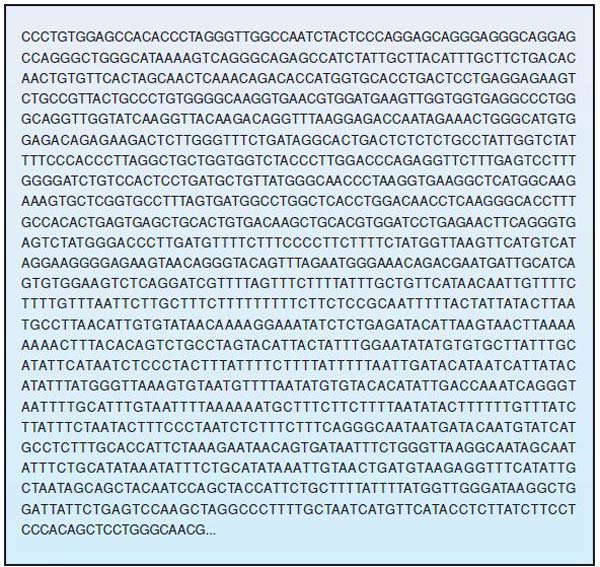 |
| The letters below are instructions for the production of hemoglobin. When the body needs hemoglobin, an enzyme called RNA polymerase identifies these letters one by one, out of three billion letters of the DNA, makes a copy of them, and orders them in the correct sequence. Later, it ferries the copied instructions to the site in the cell where production will take place. |
When a protein needs to be synthesized in the cell, an enzyme called RNA polymerase goes to the cell's information bank, locates the information in the DNA relevant to the protein, then makes a copy of it for itself. But information about the protein is sometimes found dispersed throughout different regions of the DNA. Because RNA polymerase makes a copy of the entire DNA—from where the information begins to where it ends—it inevitably ends up copying regions that are of no use. The presence of irrelevant information would then result in a useless protein being synthesized. At this stage, enzymes called spliceosomes come to the rescue and, with great precision locate and remove the irrelevant information out of hundreds of thousands of bits of data, and finally join the leftover chains together.
Molecules, made up of only a few atoms, display great consciousness in this process of RNA splicing. They virtually work like editors, determining and fixing faults and mistakes in the chain. These atoms "know" the protein that RNA polymerase is trying to make, can distinguish between vital and useless information needed to make it, and can bring about the production of the particular protein at hand out of hundreds of thousands of other bits of information—all without any mistakes. Moreover, they know immediately when they are needed and immediately travel to the relevant area to begin duty.
All that's been explained here is only one small process out of millions that take place within a cell. It is definitely impossible for atoms to possess the consciousness, knowledge, insights, skill and cooperation that such processes require.
But evolutionists' claims—that nature's most perfect systems came about as a result of coincidence—defy all rational logic and scientific understanding. Evolutionists, believing in the unbelievable, claim that nature brings about miracles, that assemblages of protons, neutrons, and electrons can act with consciousness and knowledge.
But the evolutionists are mistaken. The organizer and director of this entire conscious and planned process is God.
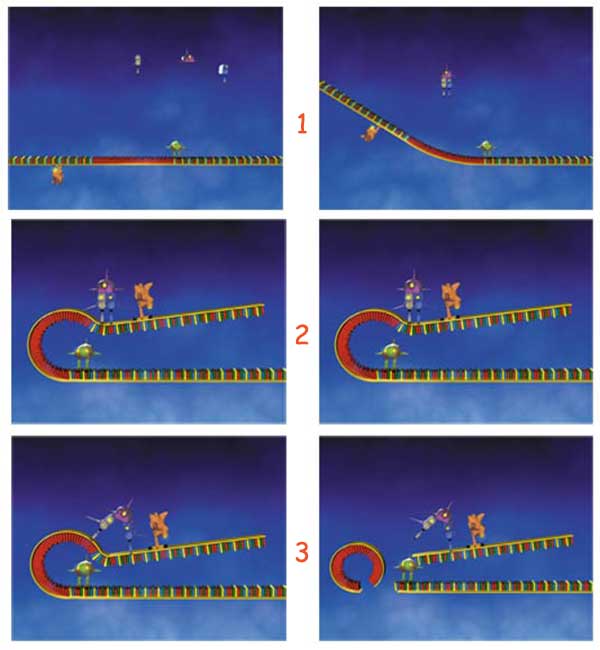 |
| 1. When a protein is going to be synthesized, instructions in the DNA are copied.Sometimes, however, the instructions can be found scattered throughout the DNA, so that the other, irrelevant bits of DNA are copied as well. In the above diagram, the irrelevant part of the DNA is marked in red. This must be deleted if the protein is to be synthesized correctly. |
When bones first start to develop, they start out as cartilage tissue. With time, the inner part of this cartilage begins to calsify and later, becomes enveloped in blood vessels by special bone cells called osteoblasts and osteoclasts. The osteoclast cells' function is to break down and resorb bone. This they do by secreting special enzymes. Not remaining idle while the osteoclasts are doing their job, the osteoblast cells form the bone.
As a result of cooperation between these two groups of cells, the bones develop and eventually form the entire skeleton.
During childhood, when growth is very rapid, the duty of the osteoblasts is much more intense. Bone formation needs to be greater than bone resorption by osteoclasts. Once the skeleton has reached a certain degree of maturity, however, the formation and resorption processes begin to balance out.
Cells to be found in the bones of every human being carry out the same duty. They all know how to build the bone. Aware of the differences, they know how to shape the bones of the skull and of the thigh, the degree of thickness each bone should have, and when to stop growing. Also, they act in awareness that they have more work to do during childhood.
In the order of any of these processes, there is no confusion. Each group of cells goes into action at exactly the required time. As a result of this planned formation, every bone attains the structure and shape it needs to perform its functions most efficiently.
How did bone cells gain this ability of planning and production? A cell formed from unconscious atoms cannot look ahead or make decisions. It can't be aware of the stress or balance in the body, sense its needs and take measures accordingly. But all of the trillions of cells in the human body act with the apparent awareness of a human being, and even display a superior intelligence. This is evidence that they are being directed and managed by a superior power. The Great Possessor of power that inspires them is God.
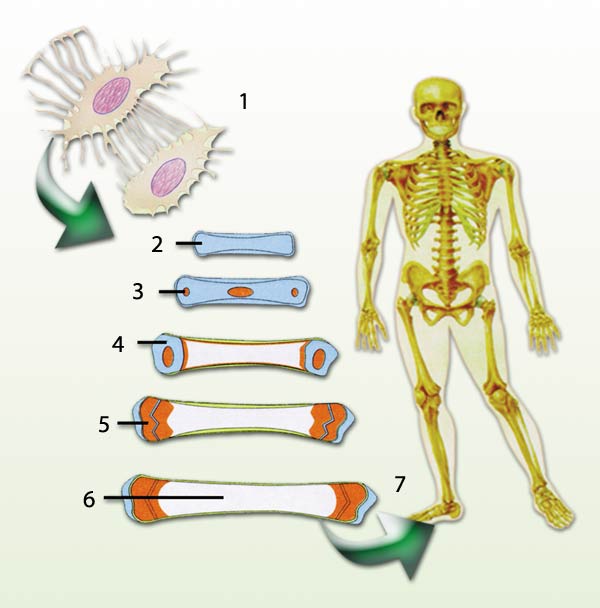 |
| 1. Bone cells |
| The human skeleton shown above was built, step by step, by tiny cells. Just like tiny sculptors, bone cells carve out the body's skeleton with great care. Who has inspired them with the knowledge of every step and how to adjust the hardness, length, shape, cavities and lumps, and points of connection? The One Who designed and built all of this so perfectly is Almighty God. |
| That is God, your Lord. There is no god but Him, the Creator of everything. So worship Him. He is Responsible for everything. (Surat al-An'am:102) |
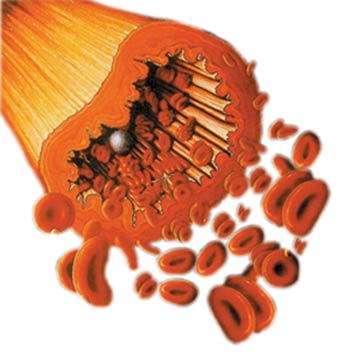 |
According to Darwinism, every living thing is a product of coincidence and chaos. But the perfect order, wonderful harmony, and sensitive balance existing throughout the universe crush Darwinist claims of coincidence. One detail in your body, which you can't see with your own eyes, will demonstrate: What gives blood its red color are the erythrocytes, or red blood cells. Erythrocytes are shaped like biconcave discs and are highly elastic—features that have the utmost importance for human life.
If red blood cells did not have such a degree of elasticity, they would become stuck at many small capillaries throughout the body, because the cells' diameter is almost twice that of the smallest blood vessels through which they flow. But because of their elasticity, this is not a problem and they can move through freely.
What would happen if erythrocytes did not have this degree of elasticity?
The answer is dramatized in people with diabetes. Their blood cells lose their elasticity and as a result, block the smaller vessels in the eyes. A result of this blockage is blindness.
Every structure and system in living things is too sensitive, too finely attuned with each other, and too balanced to leave room for the possibility of coincidence. That is because each one has evidently been created by a Possessor of superior power and knowledge—that is, by God.
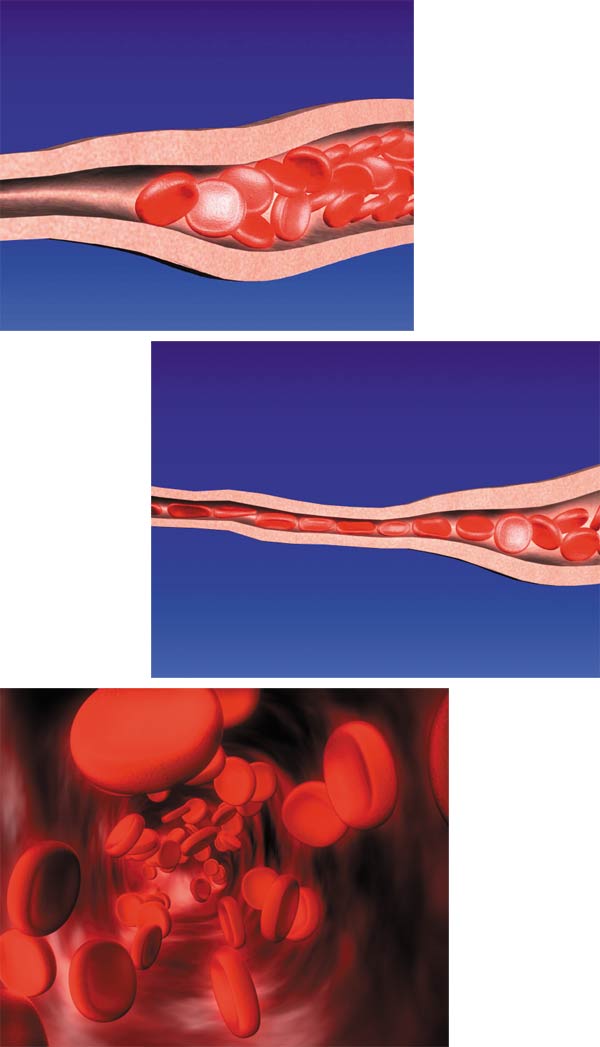 |
| The shape and elasticity of red blood cells let them pass through the finest capillaries with ease. |
| He Who created the seven heavens in layers. You will not find any flaw in the creation of the All- Merciful. Look again—do you see any gaps? Then look again and again. Your sight will return to you dazzled and exhausted! (Qur'an, 67: 3-4) |
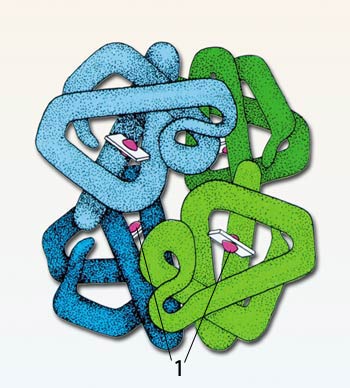 |
| 1. Heme Groups |
Red blood cells carry oxygen to every cell in our body. While the oxygen molecules are flowing freely in blood, the red blood cells need to capture them, with the use of a protein called hemoglobin.
A red blood cell is designed especially for carrying hemoglobin, which takes up 90% of the cell. Organelles like the nucleus and mitochondria, found in other cells, are lacking in red blood cells, leaving room so that their hemoglobin can capture enough oxygen.
Under no circumstances does hemoglobin make contact with oxygen molecule; because if it did, it would oxidize and thus, not allow any oxygen to reach other cells. But under normal circumstances it does not have to come into contact with oxygen as it has been created in a very special manner so as not to face this danger. Instead, it holds the oxygen molecule as if with a pair of tongs.
How does hemoglobin capture oxygen? Hemoglobin protein is composed of four subunits, each containing an iron atom bound to a heme group. These heme groups are the special "tongs" that give hemoglobin the ability to capture oxygen without contact and carry it to the cells that need it. The molecule's torsional angles change in a specific manner during oxygen binding.
Even here, within the tiniest parts of the body invisible to the naked eye, there is a most perfect and faultless harmony. It is impossible for such harmony to have come about as a result of coincidence. The emptying of the red blood cell to make room for hemoglobin, having protein "tongs" to capture oxygen without suffering a chemical reaction, the programming of the hemoglobin molecule to hunt oxygen in the first place, to recognize oxygen molecules and distinguish them from other molecules, the transport of the captured oxygen to where it's needed—none of these is a coincidence. To claim that it is is to cross over the limits of logic and reason. All of these are indications of the infinite knowledge and wisdom of God.
Along with air, we actually breathe in a lot of dust. But this and many other substances harmful to the body are held at certain "security zones" where they are neutralized before they ever get a chance to reach the lungs.
From the nose to the bronchioles, the entire surface of the respiratory pathway is coated with a layer of mucus. This substance, which also acts as a moisturizer for the respiratory surface, also traps small breathed-in particles like dust, preventing them from reaching the lungs. After these foreign particles have been caught by the mucus, however, they must be ejected out of the body, lest they build up in the respiratory passages. To effect this, another security mechanism comes into play.
Lining the respiratory surfaces are sharp-pointed flagella known as cilia, approximately 200 present on each cell. By whipping back and forth in waves, from ten to twenty times a second, these cilia facilitate regular movement—always up towards the pharynx. This way, any mucus that has trapped foreign particles is directed towards the pharynx at a rate of one centimeter per minute.
In the nose, however, mucus needs to be directed downwards, and so the cilia move in the opposite direction. This way, any foreign matter in the nasal mucus is also moved towards the pharynx. Later on, any foreign matter is either swallowed along with the mucus and taken to the digestive system, or expelled from the body through coughing.
As these examples show, these tiny hairlike structures can determine the location of the pharynx which is, relatively speaking, quite a distance away, even though they have no eyes to see with, and no brain to think. In addition, they know that if this foreign matter travels down to the lungs, it may well harm the body. To prevent this from happening, they act in a most harmonious way, beating always in the same direction.
In various experiments and using many different methods, scientists have studied this mechanism for many years. However, they still don't completely understand this mechanism, which tiny hairs only two millionth of a meter in size have been carrying on faultlessly since the first human was alive. Acting with the inspiration given to them by God Who created them, cilia perform in an ingenious way that cannot have been "rehearsed" in a series of coincidences.
 |
| Cilia in the windpipe, photographed by an electron microscope |
| And He has made everything in the heavens and eveything on the Earth subservient to you. It is all from Him. There are certainly signs in that for people who reflect. (Qur'an, 45: 13) |